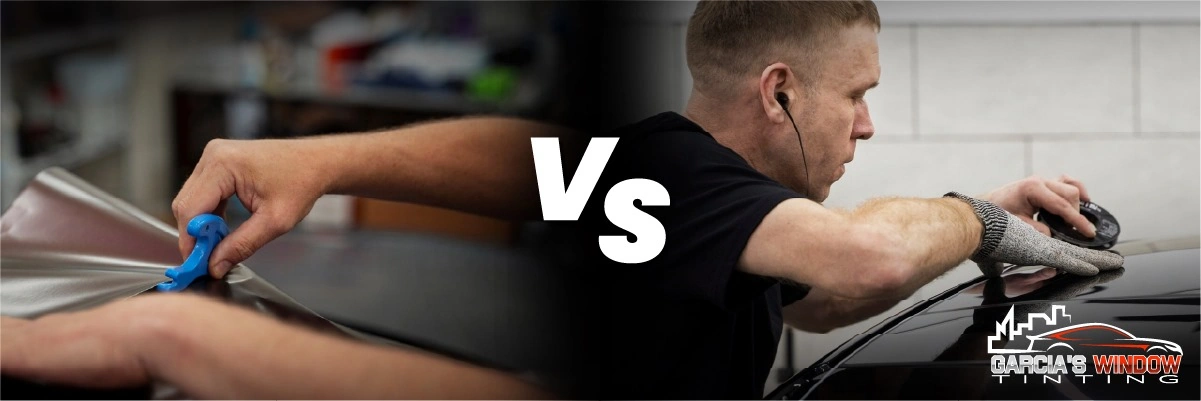Ceramic Tint vs Regular Tint: What Are The Differences?
Exploring the world of automotive window tinting leads us to a common dilemma: ceramic tint vs. regular tint. In this blog, we’ll delve into the nuances that differentiate these two options, unraveling not only the differences, but also their meaning and what material they’re made of. This will help you clarify your doubts about these two types of tinting and choose the best option for your vehicle.
What is Ceramic Window Tint?
Ceramic window tint is a type of window film that is used to reduce the amount of sunlight and heat that enters a vehicle through its windows. It’s made of multiple layers of ultra-thin film that incorporate microscopic ceramic particles.
Ceramic window tint is a premium product that offers superior UV protection, being able to block up to 99.9% of UVA and UVB rays, reduces glare and blocks infrared radiation to keep your vehicle’s interior cooler. It differs from other types of window films because it’s designed for superior clarity and contains no metal, dye, or carbon that could interfere with electronic devices such as radio, GPS, and mobile phones. However, it is more expensive than other types of window tinting.
What is Regular Window Tint?
Regular window tint, also known as dyed tint, is a type of window film that is made out of thin sheets, usually laminate or polyester-based. The gradations usually range from 10% to 90% — the lower the percentage,the harder it is to see into the vehicle. These sheets are usually dyed black, or a shade of brown or gray.
Regular window tints are a popular choice for many car owners due to their affordability. They offer a level of UV protection, which can help reduce the number of harmful rays entering your car’s interior. While they may not completely eliminate heat buildup, they can certainly help manage it.
These tints come with a scratch-resistant coating, designed to withstand everyday use. While it may not be impervious to sharp objects or projectiles, it does provide a layer of protection that can extend the life of your tint.
After having learned about the concept of these two types of window tinting, we can move on to the key point of this blog:
Differences Between Ceramic Tint and Regular Tint
The differences between Ceramic tinting and Regular tinting lie in their composition, performance, and longevity. Here’s a concise breakdown:
1. Composition:
- Ceramic Tinting: Utilizes ceramic particles in the film, which are non-metallic and non-conductive. This composition allows for excellent heat rejection without interfering with electronic signals.
- Regular Tinting: Relies on dyes and/or metallic particles for tinting effects. This composition may include materials that can interfere with electronic signals and does not offer the same heat rejection capabilities as ceramic tint.
2. Heat Rejection:
- Ceramic Tinting: Known for high heat rejection, keeping the interior cooler by blocking infrared radiation.
- Regular Tinting: Absorbs and reflects some heat but may not provide as effective heat rejection as ceramic tint.
3. UV Protection:
- Ceramic Tinting: Offers excellent protection against harmful UV rays, preventing interior fading and damage.
- Regular Tinting: Provides UV protection but may not be as effective as ceramic tint.
4. Appearance:
- Ceramic Tinting: Often has a neutral and non-reflective appearance, maintaining optical clarity.
- Regular Tinting: Comes in various appearances, including reflective, non-reflective, or colored, depending on the materials used.
5. Signal Interference:
- Ceramic Tinting: Does not interfere with electronic signals, such as radios, GPS, or cell phones, due to its non-metallic composition.
- Regular Tinting: May contain metallic particles, potentially causing interference with electronic signals.
6. Durability:
- Ceramic Tinting: Known for durability and resistance to fading over time.
- Regular Tinting: Durability can vary, and some types may be more prone to fading compared to ceramic tint.
The choice between Ceramic Tinting and Regular Tinting boils down to key distinctions in composition, heat rejection, and overall performance. Ceramic Tinting, with its non-metallic, heat-rejecting composition, offers superior clarity and UV protection. On the other hand, Regular Tinting, while more budget-friendly, may include metallic particles and presents considerations like signal interference. Your decision depends on prioritized factors, be it advanced technology, durability, or cost-effectiveness. Elevate your driving experience by making an informed choice. Ready to redefine your ride? Explore the possibilities; let’s tint your journey together.
.





